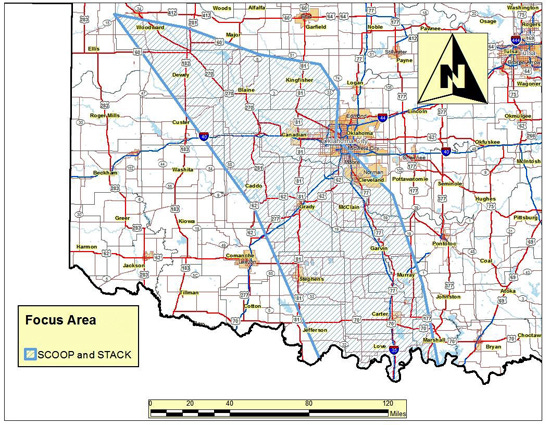OCC, OGS: New Year, New Plays, New Plans
Oklahoma’s oil and gas industry is poised to launch new, major operations in the coming year in Oklahoma’s latest oil and natural gas plays, the South Central Oklahoma Oil Province (SCOOP) and the Sooner Trend Anadarko Basin Canadian and Kingfisher counties (STACK). These areas are expected to account for the vast majority of new oil and gas activity in Oklahoma.
In a proactive approach, the Oklahoma Corporation Commission’s Oil and Gas Conservation Division (OGCD) and the Oklahoma Geological Survey (OGS) have developed seismicity guidelines focused on operators in the SCOOP and STACK. This effort has met with full cooperation on the part of the Oklahoma energy industry.

OGCD Director Tim Baker says the good news is that the SCOOP and STACK are not capable of generating huge amounts of wastewater.
“Production from the Mississippian Limestone and Hunton Dewatering Play operations within the 15 thousand square mile earthquake Area of Interest (AOI) has resulted in an unprecedented amount of salt water which was already in the formation coming up with the oil and natural gas,” Baker explained. “That produced water is put back underground using disposal wells. There is broad agreement among researchers that disposal of these large amounts of water into the state’s deepest formation (the Arbuckle) can be linked to the high earthquake rate in parts of the AOI. By comparison, the SCOOP and STACK plays have very small amounts of produced water.”
OGS Director Jeremy Boak says both old and new data have prompted a plan now to mitigate earthquake risk in the SCOOP and STACK.
“Then-state seismologist Austin Holland did some work on small earthquakes some years ago in what is now widely known as the SCOOP and STACK, and showed some of them might have been related to hydraulic fracturing,” Boak said. “More recent small events outside the AOI might also be linked to hydraulic fracturing. While the data indicates that seismicity related to the SCOOP and STACK would be far less frequent and much lower inmagnitude than the activity we are addressing in the main earthquake region of the state that has been linked to wastewater disposal, we have enough information to develop a plan aimed at reducing the risk of these smaller events as operations commence,” Boak said. “Unlike the strong earthquake activity in areas of the AOI linked to disposal activity, response to seismic activity that might be related to hydraulic fracturing can be more precisely defined and rapidly implemented.”
Both Baker and Boak stress that the major concern over the possibility of strong magnitude earthquakes remains focused on the AOI, and more actions for the AOI are being developed.



